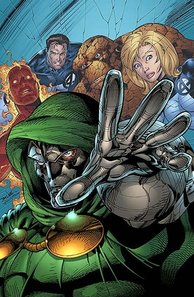 Doctor Doom, one of the most archetypal
supervillains and his arch-enemies The Fantastic Four (in
background). Art by Jim Lee.
Doctor Doom, one of the most archetypal
supervillains and his arch-enemies The Fantastic Four (in
background). Art by Jim Lee.
A supervillain is a variant of the villain character type, commonly found in comic books, action movies and science fiction in various mediums. Supervillains concoct complex and ambitious schemes to accumulate power and suppress adversaries. They often have colorful names and costumes and/or other eccentricities. Female supervillains are sometimes known as supervillainesses.
Supervillains are often used as foils to superheroes and other fictional heroes. Their extraordinary brainpower and/or superhuman abilities make them viable antagonists for the most gifted heroes.
Many supervillains share typical characteristics of real world dictators, mobsters, and terrorists.
Contents |
Common Traits
While supervillains vary greatly, there are a number of attributes that define the character. Most supervillains have at least a few of the following traits:
- A desire to commit spectacular crimes and/or rule the world—or in some cases an entire universe—through whatever means necessary.
- A generally irritable and spiteful disposition and contempt for heroes, ordinary civilians, lackeys, and anyone else who may get in their way.
- A sadistic nature and tendency to revel in their sociopathic behavior and/or supposed intellectual superiority
- An enemy or group of enemies that he or she repeatedly fights.
- A desire for revenge against said enemies. The method of revenge often goes beyond simply killing them to making them suffer before death, such as using deathtraps.
- A brilliant scientific mind that he or she chooses to use for evil (see also mad scientist and evil genius).
- Superhuman abilities or special skills, similar to those of superheroes. Frequently, these skills are gained through selfish meddling with science as opposed to the "natural" or "accidental" gifts possessed by superheroes. Compare the origins of the Green Goblin or Doctor Octopus to their nemesis Spider-Man.
- A dark and threatening-looking headquarters or lair, the location of which is usually kept secret from police, superheroes and the general public. Examples include Magneto’s headquarters Asteroid M and The Legion of Doom’s Hall of Doom. However, some supervillains who feel secure from prosecution live and work in palatial buildings, such as Doctor Doom's castles in his country of Latveria and the office buildings and research facilities of the Green Goblin’s alter ego Norman Osborne. Others are mobile and do not have one particular base of operations.
- A theme by which he or she plots his crimes. For example, The Riddler plots his crimes around riddles, puzzles and word games and Mysterio plots his around movie special effects.
- Although super villain “team-ups” occasionally occur and some supervillain teams exist, such as the Brotherhood of Mutants and Sinister Six, most supervillains do not collaborate with one another but employ a team of simple-minded and expendable henchmen to assist them. Some supervillains, such as Darth Vader and Cobra Commander, control entire armies.
- Due to a cowardly nature or physical inequality to their foes, some supervillains manipulate events from behind the scenes. These include Lex Luthor, a physical weakling compared to Superman, and Ernst Stavro Blofeld of the James Bond novel and film series.
- A strong commitment to their criminal profession to the point where they will quickly resume their activities in their favorite area immediately after escaping prison or recovering from serious injury.
- A refusal to accept responsibility for personal mistakes and setbacks in favor of blaming their enemies
- A back story or origin story that explains how the character transformed from an ordinary person into a supervillain. The story usually involves some great tragedy that marked the change. In the case of many supervillains, including Two-Face, Magneto, Doctor Doom, and some versions of Lex Luthor, this story involves a one-time friendship with their future foe.
Personality Types
One thing that supervillains do not share is motivation; characters choose to become supervillains for many different reasons:
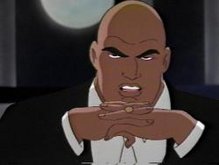 Lex Luthor from Superman: The Animated Series
Lex Luthor from Superman: The Animated Series
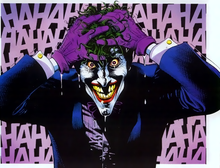 The Joker. Art by Brian Bolland
The Joker. Art by Brian Bolland
Red Skull, Lex Luthor, Professor Moriarty, and many others are portrayed as outright evil and power-hungry. Few writers attempt to portray them with any redeeming qualities. This approach was common in the Golden Age of Comic Books, but subsequent writers prefer more complex villains. Marvel Comics writer/editor Stan Lee often says it is more important that fans sympathize with villains than heroes.
Darth Vader, Venom, Zen-Aku, and the Green Goblin, have fallen under some corrupting influence. In some cases, such as the ending of Star Wars: Return of the Jedi, the character overcomes his or her manipulator and is able to somewhat redeem himself.
Sabretooth, Typhoid Mary, The Joker and most other Batman villains are criminally insane and incapable of controlling their murderous urges.
Sandman, Electro and Blob are simply thugs with superhuman abilities. They often work as henchmen of more ambitious and intelligent supervillains.
Man-Bat, The Lizard and Sauron undergo werewolf-like transformations into animalistic creatures that cannot control their savagery.
Mr. Mxyzptlk, Impossible Man and Q, are tricksters who torment heroes for their own pleasure.
Skeletor, Davros, Lord Zedd and Brainiac are extraterrestrials and their behavior is either common or encouraged on their home planets.
A few characters deemed supervillains actually have goals that could be considered noble but pursue them in extreme ways. The best-known example is the X-Men’s enemy Magneto, a Holocaust survivor who seeks to end the human oppression of mutants, but uses war and terrorism to accomplish his goals. John Sunlight, featured in Doc Savage pulp magazines, Syndrome of the movie The Incredibles, and Ozymandias of the comic book series Watchmen have large-scale utopian goals but are resort to destructive measures to implement them.
Japanese anime and tokusatsu series often feature noble villains, similar to the type described above. This type shows a sort of respect for his or her foe. As a common plot device, they, or one of their comrades or kin, owe a debt to the hero and work to repay it. However, when the debt is paid, the villain continues with his or her crimes.
A few supervillains, such as Galactus personify forces of nature and cannot be judged by simple standards of morality.
In the Modern Age of Comic Books, heroes and villains have generally become less morally absolute. While many superheroes were portrayed as psychologically complex and morally fallible, if not questionable, villains have also become more multifaceted. Psychological impulses and personal tragedy were often explored as motivations behind their behavior. During this time, many villains were “redeemed” and, either permanently or provisionally, became anti-heroes. Examples include Magneto, Elektra, Venom, Sandman, Catwoman, Emma Frost, Juggernaut and Mystique
Supervillains as Foils
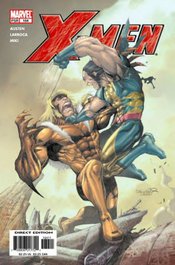 Wolverine vs. Sabretooth. Art by Salvador Larroca
Wolverine vs. Sabretooth. Art by Salvador Larroca
Many supervillains are portrayed as an inversion of their foe. For example, Wolverine constantly tries to contain his animalistic urges, while Sabretooth fully embraces his. Batman is a humorless character with a foreboding appearance, while The Joker is a comical character with a colorful appearance. The Incredible Hulk is the raging, reckless alter ego of a brilliant scientist while The Leader is the intelligent, conniving alter ego of a person of average intellect and both were transformed by gamma radiation.
Occasionally, this contrast is more direct. Bizarro is an alternate reality version of Superman from a “Bizaro World” in which everything is an inversion of its DC Universe counterpart (In the current DC Comics continuity, however, he is a flawed clone of Superman.) Like Captain Marvel, Black Adam was once a protégé of the wizard Shazam, but used his powers for evil and has returned to challenge Marvel, wearing a costume that parodies his.
These contrasts help build-up the mythic grandeur of superhero and villain relationships and allow the villain to serve as a foil for the hero.
Origins
By most definitions, the first supervillain was Professor Moriarty, the arch enemy of Arthur Conan Doyle’s detective Sherlock Holmes, introduced in 1891. Dr. Fu Manchu, the antagonist of several popular novels of Sax Rohmer, is credited with popularizing many of the typical characteristics of the modern supervillain, including his sadistic personality, his desire for world domination, and his use of sinister lairs and themed crimes and henchmen. Rohmer's work had a strong influence on Ian Fleming, whose James Bond novels and their film adaptations further popularized the image of the supervillain in popular culture.
The first supervillain who wore a bizarre costume was the Lightning, from the 1938 film Fighting Devil Dogs, which preceded the first superhero, Superman.
The first supervillain to regularly battle a Superhero was Ultra-Humanite, who first appeared in Action Comics #13 (1939).
Well-known supervillains
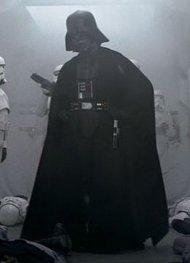 Darth Vader in the first Star Wars film
Darth Vader in the first Star Wars film
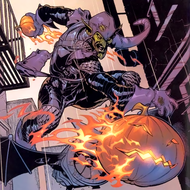 The Green Goblin. Art by Terry Dodson
The Green Goblin. Art by Terry Dodson
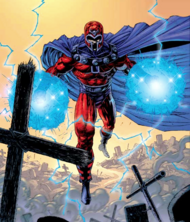 Magneto. Art by Lenial Francis Yu
Magneto. Art by Lenial Francis Yu
Cobra Commander, mysterious leader of the terrorist Cobra Organization in various G.I. Joe-related comic books and animated series.
Darkseid, ruler of the Hellish planet of Apokolips and galactic conqueror, enemy of the New Gods and the DC Comics superhero community in general.
Darth Vader, Black-cloaked Sith Lord in the original trilogy of Star Wars films, adversary of Luke Skywalker and the Jedi Knights.
Davros, physically crippled but scientifically ingenious alien adversary of the Doctor; creator of the Daleks and sometimes their leader.
Doctor Doom, mad scientist, wizard, and dictator of the fictional country of Latveria, arch-enemy of the Fantastic Four and adversary of the Marvel Comics superhero community in general.
Doctor Octopus, mad scientist with four tentacle-like metal arms, adversary of Spider-Man.
Ernst Stavro Blofeld, international terrorist leader and arch-enemy of James Bond during the early years of the film series.
Fu Manchu, the prototype of the modern supervillain, antagonist of several novels by Sax Rohmer.
Green Goblin, millionaire-by-day/costumed-madman-by-night, arch-enemy of Spider-Man.
The Joker, clown-impersonating psychopath with a warped sense of humor, arch-enemy of Batman.
Khan Noonien Singh, genetically engineered superhuman with plans for multi-world domination, adversary to the original Star Trek crew.
The Kingpin, supremely powerful New York mafia boss, adversary of Daredevil and the Marvel Comics superhero community in general.
Lex Luthor, in early incarnations, a cold-hearted mad scientist; in later, a billionaire industrialist and white collar criminal, arch-enemy of Superman.
Loki, trickster god and arch-enemy of Thor in both Marvel Comics and Norse mythology.
Magneto, mutant leader with the ability to control magnetism, protector of his people at all costs, arch-enemy of the X-Men.
Megatron, leader of the evil robot group the Decepticons from the Transformers animated series.
Ming the Merciless, interplanetary despot, adversary of Flash Gordon.
The Penguin, self-styled “gentleman of crime,” adversary of Batman.
Palpatine, former Galactic Senator and Chancellor-turned-Sith lord and galactic emperor in the Star Wars film series.
Professor Moriarty, criminal genius and adversary of Sherlock Holmes, arguably the first supervillain. Holmes described him as “the Napoleon of crime.”
The Riddler, question mark-clad criminal with an obsessive compulsive to forewarn police and heroes of his crimes with complex riddles and word games, enemy of Batman.
The Shredder, leader of the ninja crime gang the Foot Clan and arch-enemy of the Teenage Mutant Ninja Turtles.
Skeletor, other-dimensional conqueror and arch-enemy of He-Man.
Venom, A half-man, half-alien symbiote with a desire for revenge and a frequent Spider-Man adversary.
Well-known parodies of supervillains
Because the supervillain is such a common but distinct character type in modern fiction, several parodies have been created. Some of the best-known include:
Mr. Burns, crotchety power plant owner on The Simpsons, takes on the role of supervillain in various episodes, as when he builds a device to block out the sun which causes Waylon Smithers to remark: "He's gone from regular villainy to cartoonish super-villainy!" At least one episode featured a shot of Mr. Burns with the Darth Vader theme playing. Mr Burns also bears a likeness of the Evil Emperor Palpatine, another villains in the Star Wars saga.
Stewie Griffin, diabolically ingenious, talking baby of the TV series Family Guy. In earlier episodes attempted to control the weather to rid the world of broccoli, and his biggest aspiration is to kill his mother, Lois. Latter episodes have portrayed him as merely inconsiderate, prematurely grumpy and possibly gay.
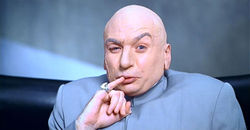 Dr. Evil in Austin Powers: International Man of
Mystery.
Dr. Evil in Austin Powers: International Man of
Mystery.
Dr. Evil, bumbling criminal mastermind and adversary of Austin Powers in a series of spy film spoofs.
The Brain, from the cartoon series Animaniacs and one of the titular stars of the spin-off show, Pinky and the Brain, is a diminutive lab mouse bent on global conquest.
Syndrome, hyperactive and schizophrenic evil genius and superhero-wannabe from the computer animated film The Incredibles, and arch-enemy of the Incredible Family.
O'Malley, the main villain and common adversary of both sides in the second and third seasons of the machinima series Red vs Blue, is an over-the-top supervillain caricature. He frequently uses clichés and ridiculous dialogue such as "You foolish fools will never defeat me! You're far too busy being foolish!", or "Prepare for an oblivion, for which there is no preparation!", usually accompanied by extreme close-ups of his helmet visor, and followed by evil laughter. He also has a penchant for plans that are unlikely to succeed, such as an effort to conquer the universe with a weather control machine (it was pointed out in a deleted scene on the Red vs Blue Season 3 DVD that it wouldn't help him fight anything in space.)
Professor Chaos, the recurring alter ego of Butters, a fourth grader on the animated series South Park, seeks to spread fear and chaos as revenge upon the world that has forsaken him (made him socially unpopular), but has a problem with scale. Exploits include switching people's soup at a restaurant, attempting to destroy the ozone layer by spraying regular aerosol cans and flooding the planet by leaving the backyard hose on. Once suffered an existential crisis prompted by the fact that all of his plans had previously been done on The Simpsons.
Dark Helmet, and the Spaceballs. A parody of Darth Vader with a new and creative twist: underneath his massive helmet is a short man wearing a tie.
Casanova Frankenstein is the villain in the 1999 movie Mystery Men. He employed several gangs of themed henchmen including the "Disco Boys." His goal was to destroy Champion City with a doomsday machine.
Other uses
- Linux users occasionally use the term "Supervillain" as a comical self-reference, inspired by the Switch to Linux cartoon by Chris Hill. The cartoon features a character named Steve, who describes how Linux helps him become a Supervillain.
External links
- The Top 100 Things I'd Do If I Ever Became An Evil Overlord, a comprehensive list by Peter Anspach of some of the most common causes of supervillain failure and how to remedy them.




 216.73.216.81
216.73.216.81 User Stats:
User Stats:
 Today: 0
Today: 0 Yesterday: 0
Yesterday: 0 This Month: 0
This Month: 0 This Year: 0
This Year: 0 Total Users: 117
Total Users: 117 New Members:
New Members:
 216.73.xxx.xx
216.73.xxx.xx
 Server Time:
Server Time: